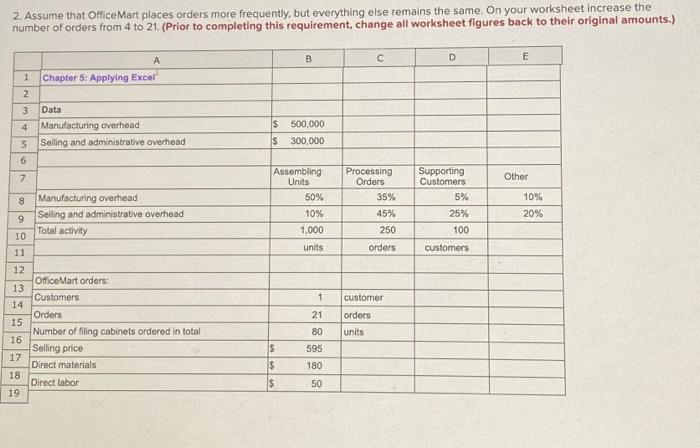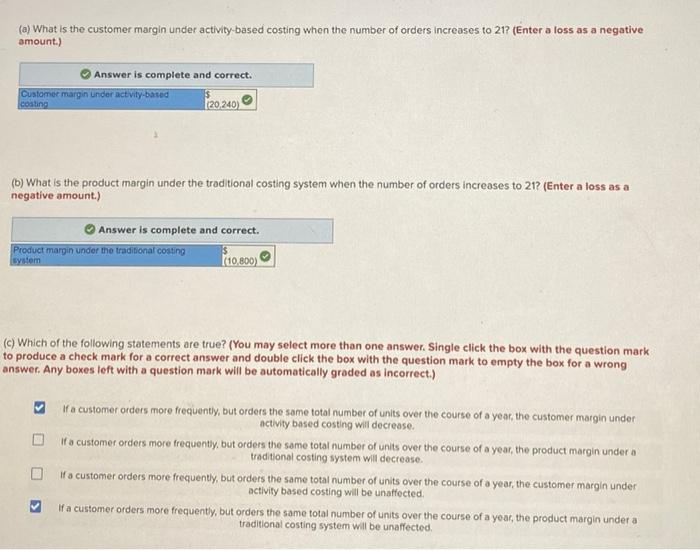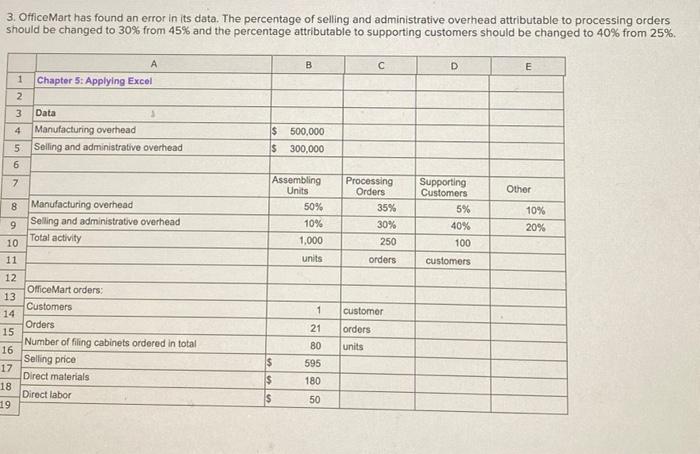Answered step by step
Verified Expert Solution
Question
1 Approved Answer
only answer 2C and 3A&C thank you! 2. Assume that OfficeMart places orders more frequently, but everything else remains the same. On your worksheet increase
only answer 2C and 3A&C
2. Assume that OfficeMart places orders more frequently, but everything else remains the same. On your worksheet increase the number of orders from 4 to 21. (Prior to completing this requirement, change all worksheet figures back to their original amounts.) A B D E 1 Chapter 5: Applying Excel 2 3 Data 4 Manufacturing overhead 5 Selling and administrative overhead $ 500,000 $ 300,000 6 7 Supporting Customers Other Assembling Units 50% 10% 1,000 Processing Orders 35% 45% 8 5% Manufacturing overhead Selling and administrative overhead Total activity 10% 20% 9 25% 100 250 10 11 units orders customers 1 12 Office Martorders: 13 Customers 14 Orders 15 Number of filing cabinets ordered in total 16 Selling price 17 Direct materials 18 Direct labor 19 customer orders units 21 80 595 180 S $ $ 50 (a) What is the customer margin under activity-based costing when the number of orders increases to 21? (Enter a loss as a negative amount.) Answer is complete and correct. Customer margin under activity-based 3 posting 120.240) (6) What is the product margin under the traditional costing system when the number of orders increases to 21? (Enter a loss as a negative amount.) Answer is complete and correct. Product margin under the traditional costing system (10,800) (c) Which of the following statements are true? (You may select more than one answer. Single click the box with the question mark to produce a check mark for a correct answer and double click the box with the question mark to empty the box for a wrong answer. Any boxes left with a question mark will be automatically graded as incorrect.) If a customer orders more frequently, but orders the same total number of units over the course of a year, the customer margin under activity based costing wil decrease. If a customer orders more frequently, but orders the same total number of units over the course of a year, the product margin under a traditional costing system will decrease If a customer orders more frequently, but orders the same total number of units over the course of a year, the customer margin under activity based costing will be unaffected, If a customer orders more frequently, but orders the same total number of units over the course of a your, the product margin under a traditional costing system will be unaffected. s 3. OfficeMart has found an error in its data. The percentage of selling and administrative overhead attributable to processing orders should be changed to 30% from 45% and the percentage attributable to supporting customers should be changed to 40% from 25% B D E 1 Chapter 5: Applying Excel 2 3 Data . 4 Manufacturing overhead 5. Selling and administrative overhead 6 $ 500,000 $ 300,000 7 Other Assembling Units 50% 10% 1,000 units Processing Orders 35% 30% 250 orders Supporting Customers 5% 40% 100 10% 20% customers 8 Manufacturing overhead 9 Selling and administrative overhead Total activity 10 11 12 OfficeMart orders: 13 Customers 14 Orders 15 Number of filing cabinets ordered in total 16 Selling price 17 Direct materials 18 Direct labor 19 1 21 customer orders units 80 595 is 180 $ $ 50 (a) Based on new number of orders in Requirement 2, what is the customer margin under activity-based costing when the data are corrected? (Enter a loss as a negative amount.) Answer is complete but not entirely correct. Customer margin under activity based costing $(5,250) (b) Based on new number of orders in Requirement 2, what is the product margin under the traditional costing system when the data are corrected? (Enter a loss as a negative amount.) Answer is complete and correct. Product margin under the traditional costing system (10,800) (c) Which of the following statements are true about what happens when the percentage of selling and administrative overhead attributable to processing orders declines and the percentage of selling and administrative overhead attributable to supporting customers increases by the same amount? (You may select more than one answer. Single click the box with the question mark to produce a check mark for a correct answer and double click the box with the question mark to empty the box for a wrong answer. Any boxes left with a question mark will be automatically graded as incorrect.) When the percentage of selling and administrative overhead attributable to processing orders declines and the percentage of selling and administrative overhead attributable to supporting customers increases by the same amount, costs are shifted from the processing orders cost pool to the supporting customers cost pool When the percentage of selling and administrative overhead attributable to processing orders declines and the percentage of selling and administrative overhead attributable to supporting customers increases by the same amount, costs will be shifted from customers who order more frequently to those who order less frequently When the percentage of selling and administrative overhead attributable to processing orders declines and the percentage of selling and administrative overhead attributable to supporting customers increases by the same amount the customer margins of those who order more frequently will increase relative to the customer margins of those who order less frequently thank you! 







Step by Step Solution
There are 3 Steps involved in it
Step: 1

Get Instant Access to Expert-Tailored Solutions
See step-by-step solutions with expert insights and AI powered tools for academic success
Step: 2

Step: 3

Ace Your Homework with AI
Get the answers you need in no time with our AI-driven, step-by-step assistance
Get Started


